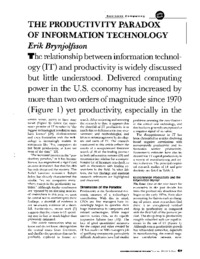The Productivity Paradox of Information TechnologyReview and Assessment
Publikationsdatum:
|
 |
 Diese Seite wurde seit mehr als 7 Monaten inhaltlich nicht mehr aktualisiert.
Unter Umständen ist sie nicht mehr aktuell.
Diese Seite wurde seit mehr als 7 Monaten inhaltlich nicht mehr aktualisiert.
Unter Umständen ist sie nicht mehr aktuell.
 Zusammenfassungen
Zusammenfassungen
 Dieses sogenannte »Produktivitätsparadoxon« wurde erstmals 1993 von Erik Brynjolfsson in seinem vielbeachteten Artikel »The productivity paradox of information technology« beschrieben. Brynjolfsson erklärte, dass es ein auffallendes Missverhältnis gebe zwischen den bemerkenswerten Fortschritten der Computerleistungen und der nur relativ langsam steigenden Produktivität ihrer Nutzer. Diese wuchs nur in gewohntem Maße, anstatt den von vielen erwarteten Sprung zu machen. Brynjolfsson griff damit eine Feststellung des US-Ökonomen Robert Solow auf, der wenige Jahre zuvor bemerkt hatte: »Das Computerzeitalter ist allgegenwärtig sichtbar, nur in der Produktivitätsstatistik nicht.«
Dieses sogenannte »Produktivitätsparadoxon« wurde erstmals 1993 von Erik Brynjolfsson in seinem vielbeachteten Artikel »The productivity paradox of information technology« beschrieben. Brynjolfsson erklärte, dass es ein auffallendes Missverhältnis gebe zwischen den bemerkenswerten Fortschritten der Computerleistungen und der nur relativ langsam steigenden Produktivität ihrer Nutzer. Diese wuchs nur in gewohntem Maße, anstatt den von vielen erwarteten Sprung zu machen. Brynjolfsson griff damit eine Feststellung des US-Ökonomen Robert Solow auf, der wenige Jahre zuvor bemerkt hatte: »Das Computerzeitalter ist allgegenwärtig sichtbar, nur in der Produktivitätsstatistik nicht.« The relationship between information technology (IT) and productivity is widely discussed but little understood. Delivered computing-power in the US economy has increased by more than two orders of magnitude since 1970 (figure 1) yet productivity, especially in the service sector, seems to have stagnated (figure 2). Given the enormous promise of IT to usher in "the biggest technological revolution men have known" (Snow, 1966), disillusionment and even frustration with the technology is increasingly evident in statements like "No, computers do not boost productivity, at least not most of the time" (Economist, 1990).
The relationship between information technology (IT) and productivity is widely discussed but little understood. Delivered computing-power in the US economy has increased by more than two orders of magnitude since 1970 (figure 1) yet productivity, especially in the service sector, seems to have stagnated (figure 2). Given the enormous promise of IT to usher in "the biggest technological revolution men have known" (Snow, 1966), disillusionment and even frustration with the technology is increasingly evident in statements like "No, computers do not boost productivity, at least not most of the time" (Economist, 1990).The increased interest in the "productivity paradox," as it has become known, has engendered a significant amount of research, but, thus far, this has only deepened the mystery. Robert Solow, the Nobel Laureate economist, has aptly characterized the results: "we see computers everywhere except in the productivity statistics." Although similar conclusions are repeated by an alarming number of researchers in this area, we must be careful not to over interpret these findings; a shortfall of evidence is not necessarily evidence of a shortfall. In fact, many of the most widely cited aspects of the "paradox" do not stand up to closer scrutiny.
This article summarizes what we know and don't know, distinguishes the central issues from diversions, and clarifies the questions that can be profitably explored in future research. After reviewing and assessing the research to date, it appears that the shortfall of IT productivity is as much due to deficiencies in our measurement and methodological tool kit as to mismanagement by developers and users of IT.
The research considered in this review reflects the results of a computerized literature search of 30 of the leading journals in both information systems and economics[1], as well as discussions with leading researchers in the field. In what follows, I have highlighted the key findings and essential research references.
 Dieser wissenschaftliche Zeitschriftenartikel erwähnt ...
Dieser wissenschaftliche Zeitschriftenartikel erwähnt ...
 Begriffe KB IB clear |  Computer Computer computer
, computer
,  Inflation
, Informationstechnikinformation technology
, Inflation
, Informationstechnikinformation technology
,  Management Management management
, management
,  Produktivität Produktivität productivity
, Produktivitätsparadoxon productivity
, Produktivitätsparadoxon
|
 Tagcloud
Tagcloud
 Zitationsgraph
Zitationsgraph
 Zitationsgraph (Beta-Test mit vis.js)
Zitationsgraph (Beta-Test mit vis.js)
 2 Erwähnungen
2 Erwähnungen 
- Digitaler Burnout - Warum unsere permanente Smartphone-Nutzung gefährlich ist (Alexander Markowetz) (2015)


- Alles überall auf einmal - Wie Künstliche Intelligenz unsere Welt verändert und was wir dabei gewinnen können (Miriam Meckel, Léa Steinacker) (2024)

 Anderswo finden
Anderswo finden
 Volltext dieses Dokuments
Volltext dieses Dokuments
 |  The Productivity Paradox of Information Technology: Artikel als Volltext ( The Productivity Paradox of Information Technology: Artikel als Volltext ( : :  , 1646 kByte; , 1646 kByte;  : :  Link unterbrochen? Letzte Überprüfung: 2021-03-21 Letzte erfolgreiche Überprüfung: 2017-09-25) Link unterbrochen? Letzte Überprüfung: 2021-03-21 Letzte erfolgreiche Überprüfung: 2017-09-25) |
 Anderswo suchen
Anderswo suchen 
 Beat und dieser wissenschaftliche Zeitschriftenartikel
Beat und dieser wissenschaftliche Zeitschriftenartikel
Beat hat Dieser wissenschaftliche Zeitschriftenartikel während seiner Zeit am Institut für Medien und Schule (IMS) ins Biblionetz aufgenommen. Beat besitzt kein physisches, aber ein digitales Exemplar. Eine digitale Version ist auf dem Internet verfügbar (s.o.). Aufgrund der wenigen Einträge im Biblionetz scheint er es nicht wirklich gelesen zu haben. Es gibt bisher auch nur wenige Objekte im Biblionetz, die dieses Werk zitieren.










 Biblionetz-History
Biblionetz-History